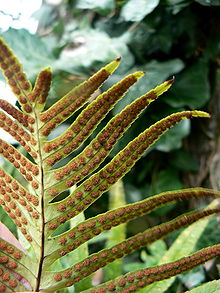Polypodium cambricum
| Polypodium cambricum | |
|---|---|

| |
| P. cambricum showing spores | |
| Scientific classification | |
| Kingdom: | Plantae |
| Clade: | Tracheophytes |
| Division: | Polypodiophyta |
| Class: | Polypodiopsida |
| Order: | Polypodiales |
| Suborder: | Polypodiineae |
| Family: | Polypodiaceae |
| Genus: | Polypodium |
| Species: | P. cambricum
|
| Binomial name | |
| Polypodium cambricum | |
Polypodium cambricum, the southern polypody,[1] limestone polypiody,[2] or Welsh polypody, is a species of fern in the family Polypodiaceae, native to southern and western Europe where it grows on shady rocks, near the coasts of the Mediterranean Basin and in the mountains of Atlantic Europe. It is a spreading, terrestrial, deciduous fern growing to 60 centimetres (24 in) tall, with pinnate fronds. The sori are yellow in winter.[3]
Name
This species has been widely known by the more apt name P. australe Fée. However, since Linnaeus did mention the species, albeit in the aberrant cambricum-form, that name must have priority.
Etymology
Polypodium is derived from the Greek Polus, many, and podion, small foot, since the rhizome bears numerous roots. The specific epithet cambricum means "Welsh",[4] from the Latinized form of Cymru, the Welsh name for Wales.
Australe comes from the Latin auter, wind of the south, for in Europe, this species grows largely in the Mediterranean Basin.[5]
Description
Perennial. Rhizome elongate, often above ground, densely covered with rusty scales. Fronds distich, 5–30 centimetres (2.0–11.8 in), glabrous, deltoid in outline; petiole yellowish green, shorter than the pinnatipartite limb. Segments 5-28 on each side; margin dentate, marked with a strong midrib. Sori round, 2–4 millimetres (0.079–0.157 in) in diameter, orange-yellow, arranged on each side of the midrib of segments. The fruits bloom from February to July.
References
- ^ "BSBI List 2007". Botanical Society of Britain and Ireland. Archived from the original (xls) on 2015-01-25. Retrieved 2014-10-17.
- ^ Hackney, P. (1977). "Polypodium australe Fee in the North of Ireland". The Irish Naturalists' Journal. 19 (4): 104–107. JSTOR 25538081.
- ^ RHS A-Z encyclopedia of garden plants. United Kingdom: Dorling Kindersley. 2008. p. 1136. ISBN 978-1405332965.
- ^ Harrison, Lorraine (2012). RHS Latin for gardeners. United Kingdom: Mitchell Beazley. p. 224. ISBN 9781845337315.
- ^ Roberts, R. H.; Synnott, D. M. (1972). "Polypodium australe Fee in Scotland and North East Ireland" (PDF). Watsonia. 9: 39–41.
